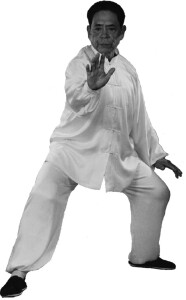
Grandmaster Feng Zhiqiang
Terminology: Hand-elbow relationship
Related terms: elbow in hand, hand on elbow; seven-inch knife; sit the wrist; forearm as a stick.
[In with elbow, no hand; out with hand, no elbow] This movement principle is a major contribution of Grandmaster Hong Junsheng to Taijiquan. This Taijiquan [Ten-word adage] clearly illustrates the importance of the relationship between the hand and elbow.
The hand-elbow relationship is the first relationship in Chen Style Taijiquan Practical Method. It is the cornerstone of the relationship between body parts.
There are two types. One is to be together as a whole, the other is to separate.
In this set of relationship, the one we are born with is to separate. Therefore, our Practical Method practice requires the hand and elbow to be together as one, which we achieve through foundation trainings, so that the two become one, a stick.
Steps:
1. In with elbow. Align the tip of the elbow with the palm of the hand, this is called elbow in hand.
2. Sit the wrist. Sit the wrist so that your palm sits on the tip of your elbow. This is called hand on elbow, or hand wrapping the elbow.
When the relationship between the hand and the elbow is established, you have a tool, a seven-inch knife. There is power!
Once the hand-elbow relationship is established, after several years of gaining and settling the ability, [then you have it].
If the hand-elbow relationship is really there, it will naturally spread throughout the body. This is the theorem, and we don’t need to worry about it. After that, you will have this unique Taiji relationship between all parts of your body, and you will be different from ordinary people!
Originally posted in Chinese by Master Chen Zhonghua. Translation-Yuxin Liu


